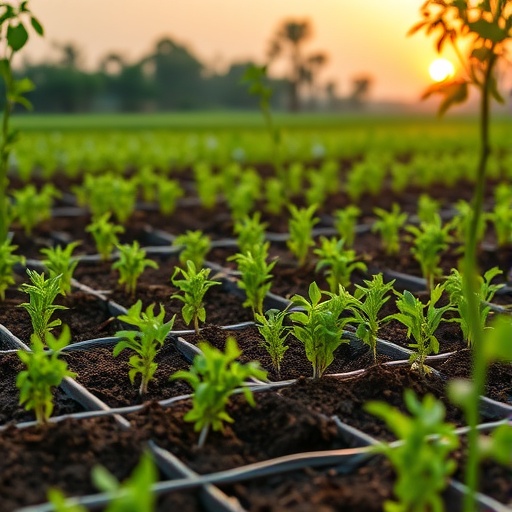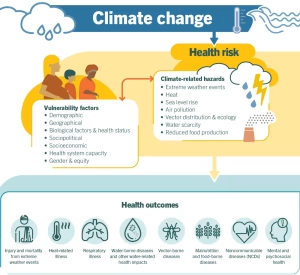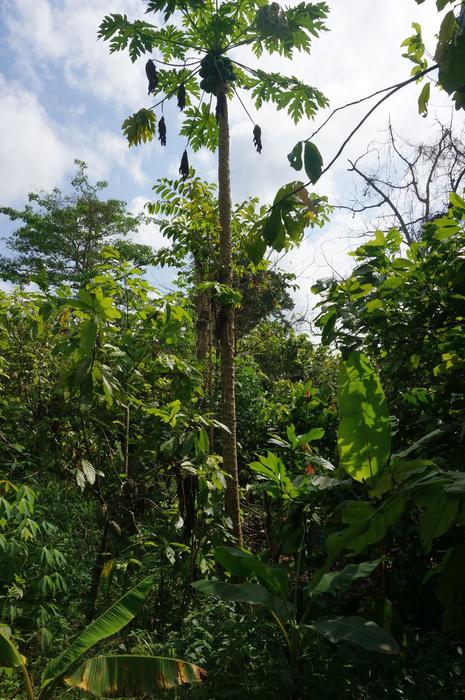Impact of Climate and Change on India’s Crop Production – BIOENGINEER.ORG

Report on the Impact of Climate and Structural Breaks on Indian Agriculture
Executive Summary
A study by Rath and Mishra, published in Discover Agriculture, analyzes the effects of climatic factors and structural breaks on the production of major commercial crops in India. The research identifies significant deviations in agricultural output trends for crops such as rice, wheat, and cotton, correlating them with climate change indicators like temperature fluctuations and erratic rainfall. The findings underscore the profound challenges to India’s agricultural sector, with direct implications for the achievement of several Sustainable Development Goals (SDGs), most notably SDG 2 (Zero Hunger), SDG 1 (No Poverty), and SDG 13 (Climate Action).
Climate Change Impacts on Agricultural Productivity and SDG 2 (Zero Hunger)
Climatic Variables and Crop Yields
The research provides empirical evidence linking altered weather patterns to agricultural instability, which directly threatens food security and the objectives of SDG 2.
- Temperature Increases: Rising temperatures are correlated with reduced yields of staple crops, jeopardizing food supply.
- Rainfall Variability: Erratic precipitation patterns disrupt critical growth phases, affecting both immediate crop health and long-term agricultural viability.
- Extreme Weather Events: An increasing frequency of such events destabilizes production patterns, creating significant risks for a consistent food supply.
Structural Breaks and Systemic Vulnerabilities
The study identifies structural breaks—significant and sustained deviations from historical production trends—as indicators of a systemic inability to adapt to new climatic realities. These breaks highlight vulnerabilities in the agricultural system that hinder the development of sustainable food production systems as targeted by SDG 2.
Socio-Economic Implications and Alignment with SDG 1 and SDG 8
Economic Instability for Agricultural Communities
Climate-induced disruptions have severe socio-economic consequences that challenge the progress toward SDG 1 (No Poverty) and SDG 8 (Decent Work and Economic Growth).
- Regions heavily dependent on specific crops face dire economic challenges, threatening the livelihoods of millions of farmers.
- The economic instability of the agricultural sector undermines its capacity to provide decent work and contribute to sustainable economic growth.
- The research emphasizes that without adaptive measures, climate change could exacerbate poverty in rural communities.
Strategic Recommendations for Sustainable Agriculture and Climate Action (SDG 12 & SDG 13)
Policy and Governance Recommendations
To build a resilient agricultural sector, the report suggests several policy actions aligned with SDG 13 (Climate Action) and SDG 12 (Responsible Consumption and Production).
- Data-Driven Policy Formulation: Utilize comprehensive data analysis to create tailored agricultural policies that address specific regional climatic impacts and capacities.
- Foster Resilient Practices: Implement government policies that prioritize and provide financial assistance for sustainable and climate-resilient farming techniques.
- Promote Public Awareness: Increase public support for research into climate-resilient crops and sustainable methods to drive systemic change.
Technological and Practical Adaptation Strategies
The study advocates for the integration of innovation and sustainable practices to mitigate the adverse effects of climate change.
- Advanced Agricultural Technologies: Promote the adoption of precision farming and resilient crop varieties to enhance productivity under new climatic conditions.
- Sustainable Practices: Ensure that technological innovations are coupled with sustainable methods to maintain ecological balance, supporting the goals of SDG 12.
- Crop Diversification: Encourage farmers to diversify crops to reduce economic risk and enhance resilience against climate-related disruptions.
The Imperative for Collaboration and Global Application (SDG 17)
Fostering Partnerships for the Goals
The research underscores the necessity of collaboration, a core principle of SDG 17 (Partnerships for the Goals), to address the complex challenges at the intersection of climate and agriculture.
- A concerted effort between scientists, policymakers, and farmers is required to facilitate knowledge exchange and equip agricultural communities with the tools to adapt.
- Such partnerships are crucial for developing and implementing effective, locally-relevant solutions.
Global Relevance
The analytical model presented by Rath and Mishra serves as a valuable framework for other nations facing similar challenges. The findings reinforce the global imperative to scrutinize and adapt local agricultural practices to ensure food security and achieve the Sustainable Development Goals in an era of climate uncertainty.
Analysis of Sustainable Development Goals in the Article
-
Which SDGs are addressed or connected to the issues highlighted in the article?
The article on the impact of climate change on India’s crop production connects to several Sustainable Development Goals (SDGs). The analysis of these connections is detailed below:
- SDG 2: Zero Hunger: This is a primary SDG addressed. The article focuses on “food security,” “agricultural productivity,” and “crop yield,” which are central to ending hunger. It highlights how climate change threatens the production of major crops like rice and wheat, directly impacting food availability.
- SDG 13: Climate Action: This is the core theme of the article. It explicitly discusses the impacts of “global warming,” “temperature fluctuations,” “erratic rainfall,” and “extreme weather events” on agriculture. The call for “adaptable farming practices” and “resilient agricultural policies” is a direct response to the need for climate action.
- SDG 1: No Poverty: The article connects agricultural stability to the economic well-being of farming communities. It mentions the “economic viability for farmers” and the “economic stability of agricultural communities,” implying that climate-induced disruptions in agriculture can exacerbate poverty, especially in rural, agriculture-dependent regions.
- SDG 8: Decent Work and Economic Growth: The article touches upon the “economic fluctuations” and “socio-economic implications” of climate change on the agricultural sector. Ensuring the stability and productivity of agriculture is crucial for the economic growth of a nation like India, where the sector is a major source of employment.
- SDG 9: Industry, Innovation, and Infrastructure: The article advocates for technological solutions and innovation to build a resilient agricultural sector. It suggests “integrating advanced agricultural technologies—such as precision farming or genetically modified organisms (GMOs)” and emphasizes the importance of “data-driven approaches to policy formulation.”
- SDG 17: Partnerships for the Goals: The article concludes by stressing the need for collaboration. It “calls for collaboration between scientists, farmers, and policymakers” and urges them to “foster environments wherein knowledge exchange is prioritized,” which is the essence of building partnerships to achieve sustainable goals.
-
What specific targets under those SDGs can be identified based on the article’s content?
Based on the issues discussed, several specific SDG targets can be identified:
- Target 2.4 (under SDG 2): “By 2030, ensure sustainable food production systems and implement resilient agricultural practices that increase productivity and production, that help maintain ecosystems, that strengthen capacity for adaptation to climate change, extreme weather, drought, flooding and other disasters and that progressively improve land and soil quality.” The article’s repeated emphasis on “resilient agricultural policies,” “adaptable farming practices,” “sustainable practices,” and creating a “resilient agricultural future” directly aligns with this target.
- Target 13.1 (under SDG 13): “Strengthen resilience and adaptive capacity to climate-related hazards and natural disasters in all countries.” The entire research discussed in the article is about understanding and responding to climate-related hazards (“temperature increases,” “variations in precipitation levels,” “extreme weather events”) to build a more resilient agricultural system.
- Target 1.5 (under SDG 1): “By 2030, build the resilience of the poor and those in vulnerable situations and reduce their exposure and vulnerability to climate-related extreme events and other economic, social and environmental shocks and disasters.” The article highlights that “regions heavily dependent on specific crops face dire challenges” and mentions the need to provide “financial assistance to struggling farmers,” which relates to protecting vulnerable populations from climate shocks.
- Target 9.5 (under SDG 9): “Enhance scientific research, upgrade the technological capabilities of industrial sectors in all countries… encouraging innovation.” The article’s suggestions to use “advanced agricultural technologies,” fund “research into climate-resilient crops,” and use “data-driven approaches” directly support the goal of enhancing research and innovation in the agricultural sector.
- Target 17.16 (under SDG 17): “Enhance the Global Partnership for Sustainable Development, complemented by multi-stakeholder partnerships that mobilize and share knowledge, expertise, technology and financial resources.” The article’s call for “collaboration between scientists, farmers, and policymakers” to ensure “knowledge exchange is prioritized” is a clear reference to the multi-stakeholder partnerships described in this target.
-
Are there any indicators mentioned or implied in the article that can be used to measure progress towards the identified targets?
The article implies several indicators that could be used to measure progress, even if it does not name them explicitly according to the official SDG framework:
- Indicator for Target 2.4: The article discusses changes in “crop yield” and “agricultural productivity” for major crops like rice, wheat, and cotton. These metrics are direct indicators of agricultural performance. Furthermore, the adoption rate of “adaptable farming practices,” “diversified crops,” and “resilient varieties” could serve as an indicator for the implementation of resilient agriculture.
- Indicator for Target 13.1: The article focuses on “structural breaks” in crop production caused by “extreme weather events.” The frequency of these breaks and the magnitude of their impact on agricultural output can be used as an indicator to measure the sector’s vulnerability and, conversely, its growing resilience to climate hazards.
- Indicator for Target 1.5: The article discusses the “socio-economic implications” for farmers. An implied indicator would be the change in income levels or economic stability of farmers in regions affected by climate-related disruptions. A reduction in the number of “struggling farmers” requiring financial assistance would signify progress.
- Indicator for Target 9.5: The article mentions the need for “increased funding for research into climate-resilient crops.” Therefore, the amount of public and private investment (R&D expenditure) in agricultural research and technology would be a direct indicator. The adoption rate of “advanced agricultural technologies” like precision farming would be another.
- Indicator for Target 17.16: The article calls for “collaboration between scientists, farmers, and policymakers.” The number and effectiveness of established partnerships, joint research projects, and knowledge-sharing platforms involving these stakeholders could serve as an indicator of progress towards this target.
-
Create a table with three columns titled ‘SDGs, Targets and Indicators” to present the findings from analyzing the article. In this table, list the Sustainable Development Goals (SDGs), their corresponding targets, and the specific indicators identified in the article.
SDGs Targets Indicators (Mentioned or Implied in the Article) SDG 2: Zero Hunger Target 2.4: Ensure sustainable food production systems and implement resilient agricultural practices. – Changes in “crop yield” and “agricultural productivity” of major crops.
– Adoption rate of “adaptable farming practices” and “resilient varieties.”SDG 13: Climate Action Target 13.1: Strengthen resilience and adaptive capacity to climate-related hazards. – Frequency and impact of “extreme weather events” on crop production.
– Occurrence of “structural breaks” in agricultural output trends.SDG 1: No Poverty Target 1.5: Build the resilience of the poor and reduce their vulnerability to climate-related events. – Measures of “economic stability of agricultural communities.”
– Number of “struggling farmers” adversely affected by climate disruptions.SDG 9: Industry, Innovation, and Infrastructure Target 9.5: Enhance scientific research and encourage innovation. – Level of “funding for research into climate-resilient crops.”
– Adoption rate of “advanced agricultural technologies” like precision farming.SDG 17: Partnerships for the Goals Target 17.16: Enhance multi-stakeholder partnerships. – Number and effectiveness of “collaboration between scientists, farmers, and policymakers.”
– Existence of platforms for “knowledge exchange.”
Source: bioengineer.org
What is Your Reaction?
 Like
0
Like
0
 Dislike
0
Dislike
0
 Love
0
Love
0
 Funny
0
Funny
0
 Angry
0
Angry
0
 Sad
0
Sad
0
 Wow
0
Wow
0
















































:focal(1500,1000)/https://media.globalcitizen.org/a6/9a/a69a4720-d8a1-4715-b596-18738d03c05c/rotary_polio_hero_image.jpg?#)







/countries/sri-lanka/photo-credit---dmc-sri-lanka.tmb-1200v.jpg?sfvrsn=dc298bcc_1#)


















